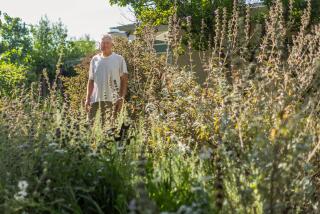Gardening : ‘Spring, Part II’ Arrives at Garden in Your Area : Agapanthus and hydrangeas are late bloomers, waiting until June to flower.
- Share via
In Southern California, spring has a sequel, a Part II.
While most flowers bloom in April or May, a second wave of flowers bloom now. The stars of this sequel are not Captain Kirk and Indiana Jones, but agapanthus and hydrangeas, both of which wait until June to bloom.
It is a good thing, too, and worth making note of. So many flowers bloom earlier in spring that gardens tend to look a little exhausted about now unless they have some of these June flowers in their beds and borders.
Agapanthus are the common lavender or periwinkle-blue flowers seen in park ways and around municipal buildings. But they are only common in Southern California, and are one of the first things Eastern and English gardeners notice on visits here.
Their commonness shouldn’t be a reason for excluding them from the garden, especially the dwarf varieties that fit in with so many other flowers of a similar height. These are ‘Peter Pan,’ which have blue flowers on 1 1/2-foot stems, or ‘Peter Pan White,’ ‘Henry,’ ‘Rancho White’ or just plain dwarf white, which are all white-flowered versions of ‘Peter Pan.’
Hydrangeas hardly need an introduction, although you might keep an eye open for the so-called “lace-cap” varieties that do not make the big balls but have flowers that are open and airy like lace. These are new to Southern California, pink flowered and very pretty, although they will never have the old-fashioned charm, or impact, of the big hydrangeas.
Perfect Companions
There are other flowers that seem their best right now.
Certainly the white Shasta daisies are at their peak in June. And they happen to be the perfect companions for agapanthus. The dwarf kinds, such as frilly ‘Esther Read’ or the diminutive, foot-tall ‘Little Miss Muffet’ (also sold as ‘Silver Princess’ and ‘Little Princess’) go perfectly with the dwarf agapanthus.
And, with a little searching you can find the old-fashioned tall Shastas to plant with the tall agapanthus. The most common old-fashioned Shasta is named ‘Alaska.’
Last year’s All-America Award-winning Shasta named ‘Snow Lady’ was a big disappointment in my garden, so much so that I wonder if it was labeled wrong at the nursery. I’d be curious to hear from others who have grown it.
The bright golden-yellow coreopsis are in full flower now, but unlike the other June-bloomers, they will continue right into and probably through summer. The bedding salvias Salvia farinacea, both the woolly, white variety and the “blue” bedding variety, also look good now but they, too, continue into summer.
Little Sun, Little Shade
You could actually use all of these together to make a June garden, perhaps for a June bride. The hydrangeas could go against the house, in the shade. The agapanthus could go in front of these, where the shade begins to turn to sun, since this is what agapanthus seem to like best, a little sun and a little shade. The Shasta daisies could go in front of the agapanthus and in front of these, in bright sun, the coreopsis and salvias.
One other June bloomer should be singled out because it makes such a spectacle but is so unknown. This is the lion’s tail, Leonotis leonurus. This is a big, herby-looking shrub, 6 feet tall by 8 or 10 feet across, and right now it is covered with the most brilliant orange flowers that look like fat spikes of lupin.
And it is a shade of orange that goes well with other flower colors. After it flowers, it must be cut back hard, and looks poor for a few weeks, but then it rebounds and blooms again is late summer or fall. Definitely a plant worth looking for, but give it the room it requires because it can, and will, shove other plants aside in its quest for space.
Spring, The Sequel, also has its own garden chores and opportunities.
First on the list of June jobs should be the last-minute planting of summer annuals and vegetables, including those zinnias and tomatoes. The off-and-on overcast weather lets you get them started before it really heats up (usually right after the Fourth of July).
Prop Up Fruit Tress
In general, however, it is not a good idea to do any planting from now until mid-September, unless you are prepared to water every day or even twice a day until plants have become established.
Fruit trees are either ripening fruit or are about to, and you will want to check heavily laden branches to see if they might need a little propping up. This was a sure sign of summer when I was a child--the sturdy 2-by-2-inch props supporting drooping branches covered with plums, peaches and apricots--a sign that the gardener knew his craft.
Hedges and shrubs, in general, have put on their spring growth, and before summer arrives, it is a good idea to trim them back if they need it. Pruned now they will not immediately rebound with new growth.
Be sure to cut off the fading flower spikes of spring’s first flowers so the plant wastes no effort on making seed. This is especially important on some flowers--foxgloves are an example--that can scatter seed all over the garden making weeds of themselves.
Lawns need fertilizing this month, more than during most, because they have probably used up whatever was available during that first spring flush of growth.
And, it’s about time to string up the hammock, near the peach tree, of course, because summer is on its way.






